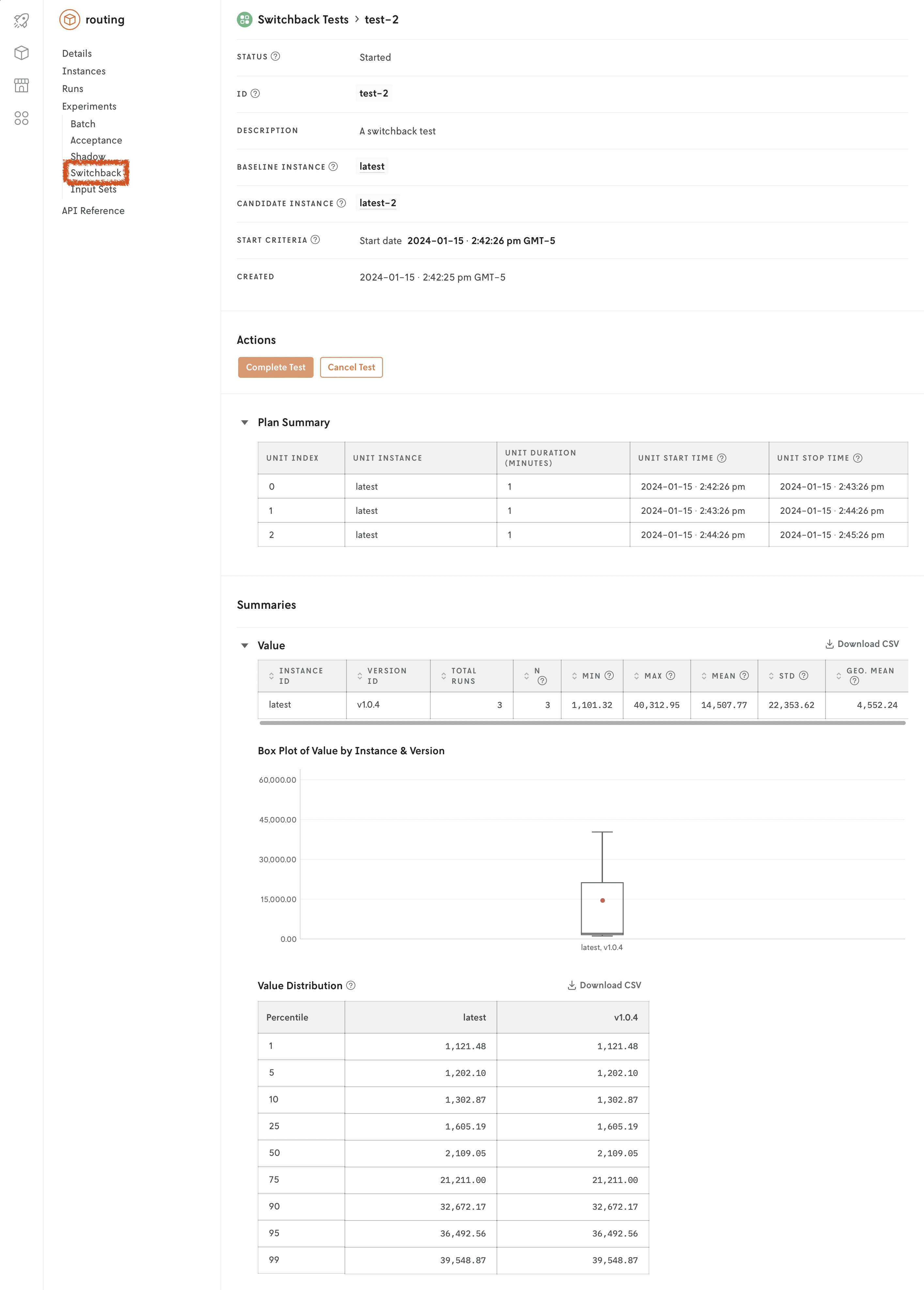A switchback test is an experiment that runs in the background and compares the results of two instances: baseline vs. candidate. The test switches back and forth between the two instances, when a run is made to the app, hence the name. Switchback experiments are related to general A/B tests, but they are not the same. Switchback experiments allow you to account for network effects, whereas A/B tests do not. However, the working principle is the same: you compare the results of two instances to determine which one is better.
The schedule by which instances are switched is called a plan. A plan consists of multiple units, each referring to a time of day and an instance. This crucial ingredient is the actual sequence of switches. Often users randomize the assignment of instances over the units. But there exist more advanced methods to design an optimal experimentation plans [1].
To be concise, when a run is submitted to the baseline instance, the test determines if the input should be routed (or not) to the candidate instance, based on the plan. Once the test is completed, the results are compared with the same framework as in a batch experiment.
The switchback experimentation currently supports generating a random plan, which means for each unit a random instance is chosen. If you need more control over the switchback plan or are interested in more advanced methods, please contact support.
Let's take a look at an example.
The following example designs a very short switchback experiment of 2 hours. It switches between the prod and the candidate instances when making runs to the baseline instance (prod in this case).
| Time | Instance | Unit index |
|---|---|---|
| 14:00 - 14:30 | prod | 0 |
| 14:30 - 15:00 | candidate | 1 |
| 15:00 - 15:30 | prod | 2 |
| 15:30 - 16:00 | candidate | 3 |
So, executing a run on the app at 14:23 routes the request to the prod instance, while making the same request at 14:35 routes the request to the candidate instance. Both runs are linked to the same switchback experiment and can later be analyzed using the unit index.
A switchback test is defined by the following parameters:
start(optional): when the test should start collecting data. The test can be started manually before thestarttime, but it will not begin collecting data until this start time is reached. If thestarttime is omitted, the plan will be executed immediately when the test is started.unit_duration_minutes: the duration, in minutes, that each unit should be active for. The total duration of theplanwill be the number ofunitsmultiplied by theunit_duration_minutes.units: the number ofplanunits that should be generated.
These are the steps to start a switchback test:
- Create the switchback test. This step is like creating a draft of the test.
- Start the switchback test. A test does not start automatically even if the time defined by
startis reached. You must start the test manually.
Please note that by default a switchback test auto-completes once 1,000 runs have been reached. If you need more runs, please contact support.
A switchback test may be manually completed or canceled at any time, if you don't want to wait until the plan is fulfilled. Once a switchback test starts, you can view partial results in the Console web interface, without having to wait for the test to complete. Results will be updated as the test progresses and finishes.
Switchback tests are designed to be visualized in the Console web interface. Go to the app, Experiments > Switchback tab.

There are several interfaces for creating shadow tests:
Console
Go to the Console web interface, and open your app. Go to the Experiments > Switchback tab. Click on New Switchback Test. Fill in the fields.

You can either create the switchback test in draft mode and start it later, or start it right away. Once the switchback test is started, you can view partial results, without having to wait for the test to complete. You can also cancel or complete the test at any time.
Cloud API
Define the desired switchback test ID and name.
Create the switchback test.
POSThttps://api.cloud.nextmv.io/v1/applications/{application_id}/experiments/switchbackCreate a switchback test in draft mode.
Create a switchback test in draft mode.
Start the switchback test. A blank output means the switchback test has started.
PUThttps://api.cloud.nextmv.io/v1/applications/{application_id}/experiments/switchback/{switchback_id}/startStart switchback test.
Start switchback test.
You can stop the switchback test at any time. The intent can be complete or cancel, depending on which label you want to attribute to the test. The results will be kept in both cases. A blank output means the switchback test has stopped.
Stop switchback test.
Stop switchback test.
References
1: Bojinov, I., Simchi-Levi, D. and Zhao, J., 2023. Design and analysis of switchback experiments. Management Science, 69(7), pp.3759-3777. https://arxiv.org/abs/2009.00148